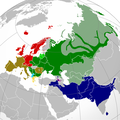Fichier:Indo-European branches map.png

Taille de cet aperçu : 599 × 600 pixels. Autres résolutions : 240 × 240 pixels | 479 × 480 pixels | 767 × 768 pixels | 1 023 × 1 024 pixels | 2 045 × 2 048 pixels | 2 934 × 2 938 pixels.
Fichier d’origine (2 934 × 2 938 pixels, taille du fichier : 2,16 Mio, type MIME : image/png)
Historique du fichier
Cliquer sur une date et heure pour voir le fichier tel qu'il était à ce moment-là.
| Date et heure | Vignette | Dimensions | Utilisateur | Commentaire | |
|---|---|---|---|---|---|
| actuel | 26 septembre 2022 à 05:43 |  | 2 934 × 2 938 (2,16 Mio) | Alexikoua | minor fixes |
| 30 mars 2022 à 17:58 |  | 2 934 × 2 938 (1,74 Mio) | Whoop whoop pull up | Whoops, wrong file! | |
| 30 mars 2022 à 17:37 |  | 2 048 × 2 048 (980 kio) | Whoop whoop pull up | Misc fixes (Russian minority in Svalbard & Israel, Slovenian in SE Carinthia, Greek in N Epirus, Aromanians/Megleno-Romanians, Swedish essentially extinct in Estonia, etc. | |
| 22 décembre 2021 à 11:37 |  | 2 934 × 2 938 (1,74 Mio) | Ahmet Q. | Reverted to version as of 19:55, 23 August 2021 (UTC)seek consensus for your changes | |
| 25 novembre 2021 à 22:40 |  | 2 934 × 2 938 (2,16 Mio) | Alexikoua | rv elimination of Greek minority in Albania | |
| 23 août 2021 à 21:55 |  | 2 934 × 2 938 (1,74 Mio) | Ahmet Q. | Rv false edit summary. Overrepresentation of Greeks in Turkey, Albania and Ukraine. Unexplained removal of Romanian in Serbia. Overall deterioration of the original file. Seek consensus for your changes. | |
| 7 août 2021 à 18:16 |  | 2 934 × 2 938 (2,16 Mio) | Demetrios1993 | Addition of Arbereshe linguistic minority in Sicily. Addition of Serbian, Bosnian, and Gorani linguistic minorities in Kosovo. Addition of Greek linguistic minorities in Italy, Albania, Turkey, and Ukraine. Including some other minor corrections. | |
| 19 novembre 2020 à 19:00 |  | 2 934 × 2 938 (1,74 Mio) | Golden | update Armenian | |
| 31 mars 2018 à 20:42 |  | 1 479 × 1 479 (574 kio) | Maphobbyist | Removed area that exactly corresponds to the non-Indo European Lezgi linguistic area. | |
| 6 septembre 2016 à 23:37 |  | 1 479 × 1 479 (620 kio) | Rob984 | Georgia and Azerbaijan aren't majority multilingual. Older generations speak Russian from the Soviet era but now English is taught mainly in place of Russian. More people speak English in Finland, yet that isn't coloured. Also corrections to Celtic are... |
Utilisation du fichier
Les 2 pages suivantes utilisent ce fichier :
Usage global du fichier
Les autres wikis suivants utilisent ce fichier :
- Utilisation sur ast.wikipedia.org
- Utilisation sur ban.wikipedia.org
- Utilisation sur be-tarask.wikipedia.org
- Utilisation sur be.wikipedia.org
- Utilisation sur bg.wikipedia.org
- Utilisation sur cs.wikipedia.org
- Utilisation sur da.wikipedia.org
- Utilisation sur de.wikipedia.org
- Utilisation sur en.wikipedia.org
- Utilisation sur en.wikiversity.org
- Utilisation sur es.wikipedia.org
- Utilisation sur et.wikipedia.org
- Utilisation sur eu.wikipedia.org
- Utilisation sur fa.wikipedia.org
- Utilisation sur fi.wikipedia.org
- Utilisation sur frr.wikipedia.org
- Utilisation sur gl.wikipedia.org
- Utilisation sur gu.wikipedia.org
- Utilisation sur gv.wikipedia.org
- Utilisation sur hak.wikipedia.org
- Utilisation sur he.wikipedia.org
- Utilisation sur hy.wikipedia.org
- Utilisation sur hyw.wikipedia.org
- Utilisation sur ilo.wikipedia.org
- Utilisation sur incubator.wikimedia.org
- Utilisation sur io.wikipedia.org
- Utilisation sur it.wikipedia.org
- Utilisation sur ja.wikipedia.org
Voir davantage sur l’utilisation globale de ce fichier.



